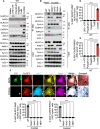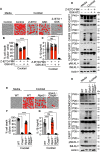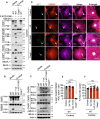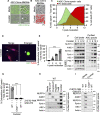Integrated NLRP3, AIM2, NLRC4, Pyrin inflammasome activation and assembly drive PANoptosis
- PMID: 38008850
- PMCID: PMC10687226
- DOI: 10.1038/s41423-023-01107-9
Integrated NLRP3, AIM2, NLRC4, Pyrin inflammasome activation and assembly drive PANoptosis
Abstract
Inflammasomes are important sentinels of innate immune defense; they sense pathogens and induce the cell death of infected cells, playing key roles in inflammation, development, and cancer. Several inflammasome sensors detect and respond to specific pathogen- and damage-associated molecular patterns (PAMPs and DAMPs, respectively) by forming a multiprotein complex with the adapters ASC and caspase-1. During disease, cells are exposed to several PAMPs and DAMPs, leading to the concerted activation of multiple inflammasomes. However, the molecular mechanisms that integrate multiple inflammasome sensors to facilitate optimal host defense remain unknown. Here, we discovered that simultaneous inflammasome activation by multiple ligands triggered multiple types of programmed inflammatory cell death, and these effects could not be mimicked by treatment with a pure ligand of any single inflammasome. Furthermore, NLRP3, AIM2, NLRC4, and Pyrin were determined to be members of a large multiprotein complex, along with ASC, caspase-1, caspase-8, and RIPK3, and this complex drove PANoptosis. Furthermore, this multiprotein complex was released into the extracellular space and retained as multiple inflammasomes. Multiple extracellular inflammasome particles could induce inflammation after their engulfment by neighboring macrophages. Collectively, our findings define a previously unknown regulatory connection and molecular interaction between inflammasome sensors, which drives the assembly of a multiprotein complex that includes multiple inflammasome sensors and cell death regulators. The discovery of critical interactions among NLRP3, AIM2, NLRC4, and Pyrin represents a new paradigm in understanding the functions of these molecules in innate immunity and inflammasome biology as well as identifying new therapeutic targets for NLRP3-, AIM2-, NLRC4- and Pyrin-mediated diseases.
Keywords: Excellular ASC; Inflammatory Cell Death; Multiple Inflammasome; PANoptosis; PANoptosome.
© 2023. The Author(s), under exclusive licence to CSI and USTC.
Conflict of interest statement
The authors declare no competing interests.
Figures







Similar articles
-
AIM2 forms a complex with pyrin and ZBP1 to drive PANoptosis and host defence.Nature. 2021 Sep;597(7876):415-419. doi: 10.1038/s41586-021-03875-8. Epub 2021 Sep 1. Nature. 2021. PMID: 34471287 Free PMC article.
-
Advances in Understanding Activation and Function of the NLRC4 Inflammasome.Int J Mol Sci. 2021 Jan 21;22(3):1048. doi: 10.3390/ijms22031048. Int J Mol Sci. 2021. PMID: 33494299 Free PMC article. Review.
-
Cytokine Secretion and Pyroptosis of Thyroid Follicular Cells Mediated by Enhanced NLRP3, NLRP1, NLRC4, and AIM2 Inflammasomes Are Associated With Autoimmune Thyroiditis.Front Immunol. 2018 Jun 4;9:1197. doi: 10.3389/fimmu.2018.01197. eCollection 2018. Front Immunol. 2018. PMID: 29915579 Free PMC article.
-
Tryptanthrin suppresses multiple inflammasome activation to regulate NASH progression by targeting ASC protein.Phytomedicine. 2024 Aug;131:155758. doi: 10.1016/j.phymed.2024.155758. Epub 2024 May 28. Phytomedicine. 2024. PMID: 38843643
-
Recent advances in inflammasome biology.Curr Opin Immunol. 2018 Feb;50:32-38. doi: 10.1016/j.coi.2017.10.011. Epub 2017 Nov 10. Curr Opin Immunol. 2018. PMID: 29128729 Free PMC article. Review.
Cited by
-
Exosomes derived from FN14-overexpressing BMSCs activate the NF-κB signaling pathway to induce PANoptosis in osteosarcoma.Apoptosis. 2025 Apr;30(3-4):880-893. doi: 10.1007/s10495-024-02071-z. Epub 2025 Jan 20. Apoptosis. 2025. PMID: 39833632 Free PMC article.
-
Probenecid Inhibits NLRP3 Inflammasome Activity and Mitogen-Activated Protein Kinases (MAPKs).Biomolecules. 2025 Apr 1;15(4):511. doi: 10.3390/biom15040511. Biomolecules. 2025. PMID: 40305196 Free PMC article.
-
NADPH acts as an endogenous P2X7 receptor modulator to gate neuroinflammatory responses of microglia.Acta Pharmacol Sin. 2025 Aug 11. doi: 10.1038/s41401-025-01638-z. Online ahead of print. Acta Pharmacol Sin. 2025. PMID: 40789938
-
Cell death shapes cancer immunity: spotlighting PANoptosis.J Exp Clin Cancer Res. 2024 Jun 15;43(1):168. doi: 10.1186/s13046-024-03089-6. J Exp Clin Cancer Res. 2024. PMID: 38877579 Free PMC article. Review.
-
Inflammasomes: potential therapeutic targets in hematopoietic stem cell transplantation.Cell Commun Signal. 2024 Dec 18;22(1):596. doi: 10.1186/s12964-024-01974-3. Cell Commun Signal. 2024. PMID: 39695742 Free PMC article. Review.
References
-
- Robinson KS, Teo DET, Tan KS, Toh GA, Ong HH, Lim CK, et al. Enteroviral 3C protease activates the human NLRP1 inflammasome in airway epithelia. Science. 2020;370:eaay2002. - PubMed
Publication types
MeSH terms
Substances
Grants and funding
- 2022R1C1C1007544/National Research Foundation of Korea (NRF)
- HV22C015600/Korea Health Industry Development Institute (KHIDI)
- 2022-NI-072-00/Ministry of Health, Welfare and Family Affairs | Korea National Institute of Health (KNIH)
- 1.220112.01/Ulsan National Institute of Science and Technology (UNIST)
- 1.220107.01/Ulsan National Institute of Science and Technology (UNIST)
LinkOut - more resources
Full Text Sources
Miscellaneous

